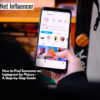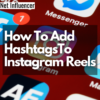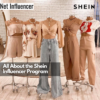Technology
WeArisma: Uncovering the Invisible 90% Of Creator Marketing’s Impact
Are brands missing a large portion of conversations about their products?
While marketing teams focus on official channels and campaigns, the majority of content about brands exists beyond their radar – untagged mentions in videos, organic product appearances in creator content, and audience-generated posts inspired by influencers.
“The main challenge with influencer marketing and the creator economy is that it is incredibly difficult for marketers to understand return on investment, to understand how to predict and how to scale,” explains Jenny Tsai, founder and CEO of London-based social and influencer intelligence platform WeArsima.

“What they know very little about is nine times out of ten is actually other people talking about them without them being there, not even part of their campaign, just in general. And the question is, what are they saying about the brands?”
Founded in 2015, WeArisma developed analytics technology that captures this unseen brand impact, serving global enterprise brands seeking to maximize their return on investment in the creator economy.
Jenny’s approach to solving this problem stems from her quantitative background in financial engineering at Princeton University. Before founding WeArisma, she held senior positions at major media companies including Sky and Hearst.
Her inspiration came from seeing how data analytics was transforming other fields, particularly baseball, as depicted in the movie “Moneyball” where analysts leveraged statistics to understand how to identify overlooked talent.
This concept of using data to find hidden value became Jenny’s guiding principle as she observed the explosive growth of social media.
“People are the new brands,” she notes. “If you want to find out what’s happening around, let’s say the World Cup, you can find out directly from the players themselves what they’re posting in the locker rooms and so on.”
WeArisma’s platform has identified over 130 million influential accounts across 70 countries, providing brands with thorough visibility into who’s talking about their products, whether they’re mentioned explicitly or not. Last June, the firm secured £2.5M in a funding round led by Adjuvo.
“Influencer content can talk way more about your brand and reach way more people than what your brand can do directly,” Jenny emphasizes.
Uncovering the 90%
WeArisma’s platform is built around three interconnected product suites that work together to provide a complete view of creator impact:
1. Execution Through Visual AI
The first pillar focuses on helping brands identify and collaborate with creators efficiently. What sets WeArisma apart is its AI-powered visual influence search capability.
“Even if your brand is not necessarily tagged by any brand advocates and influencers out there, you can actually identify that from a visual standpoint finding your product directly that are being mentioned in a video just based on visual matching,” Jenny explains.
This visual AI capability allows brands to discover creators who are already genuine supporters of their products without relying on text mentions or hashtags. As Jenny notes, “You can find people who already posted about your brand without mentioning your brand and then you can actually contact them.”
2. Measuring Total Impact
The second pillar, focused on impact measurement, captures what Jenny calls the “ripple effect” – the additional content and conversations generated by people who were inspired by the original campaign.
“If you actually do a campaign right, you can actually get people who really want to also talk about your product as a result of seeing an influencer post,” she says. “To us it’s really important to measure that because that’s definitely linked to your campaign. But quite often it doesn’t get reported because influencer marketers often only get access to systems that help them track what influencer they invited to the campaigns posting.”
This comprehensive view allows brands to understand the true reach and impact of their creator partnerships beyond first-level engagement metrics.
3. Strategy Insights and Conversation Analysis
The third pillar connects measurement to strategic planning by analyzing the broader conversations happening around products and categories.
“We don’t think you should select an influencer in a vacuum,” Jenny asserts. “What you really need to do is actually understand what are the conversations that are happening. So maybe influencers who are creating great engagement about your product. Actually their followers seem to be really interested in this TV show, or this movie, even in these musicians, or this song.”
These insights help brands identify new communities to engage with and inform content creation for their owned channels, creating a more integrated approach to creator partnerships.
The Earned Brand Influence Value
To provide a more balanced evaluation of creator impact, WeArisma developed a proprietary metric called “Earned Brand Influence Value” that measures both quantity and quality of influence.
“If I am a really big brand and I have a huge budget, I can probably get a huge number of impressions or media value,” Jenny explains. “But if I actually compare that brand with a much smaller brand that is actually growing very quickly and have very genuine people who just are advocating in my brand completely without me doing campaign, just say, ‘Have you heard about this brand?'”
The Earned Brand Influence Value combines two qualitative factors.
First is resonance—how deeply content connects with audiences beyond basic reach, including metrics like comment quality, shares, saved content, and engagement relative to audience size.
“How and when you are reached, whether people are actually resonating on that,” Jenny details.
Second is consistency, which examines both loyalty (whether influencers mention a brand repeatedly over time without payment) and advocacy (if they actively recommend products rather than just featuring them).
This helps distinguish between high-follower creators with minimal engagement versus those with smaller but more engaged audiences, one-time mentions versus ongoing relationships, and passive placement versus active recommendations.
Real-World Application
A large travel company provides a practical example of how WeArisma’s insights create tangible value. As Jenny shares, the company struggled with monitoring and responding to sentiment in the comments on their influencer posts.
“What they need to understand is within minutes what is the sentiment of those posts and how influencers are actually making them feel,” she explains. “They realize a lot of the comments below are actually not very positive. But it’s also not about the influencer, it’s actually about the brands.”
Using WeArisma’s analytics, the company could quickly categorize and analyze these comments, identifying patterns like customer service complaints. This allowed them to respond quickly:
“Influencers can then actually stream and say, ‘Okay guys, I’ve heard you, I heard you about this. And this is what we’re going to do about it,'” Jenny notes. “The last thing you want is to have an influencer campaign and then people arrive, they don’t just look at the influencer post, they read the stuff below. And for them to actually say what the influencer is saying is not true because all these other customers are not happy.”
The Balance of Analytics and Creative Freedom
Jenny sees genuine human connections becoming increasingly important in an AI-influenced field.
“With the rise of AI, actually I think human connections are more important than ever,” she states. “I think that influencers’ ability to connect with their audience is going to be very much valued because you and I all have headphones and walk down the street. We listen, we have our phone, we feel like we have a personal connection with the accounts that we follow closely.”
Jenny’s perspective on the future emphasizes that creator marketing requires both analytical insights and creative freedom:
“Creator marketing in general is not either an art or a science, but it’s both,” she observes. “The science portion, which we’re really looking to delve very deeply into, should just provide the frame and the understanding like the strategic side. But then individual creators and influencers, after you trust them and partner with them, you need to let them individually create art in a way.”
For brands evaluating their approach to creator partnerships, Jenny offers this advice: “Make sure that you do have some bearings whether it’s analytics, intelligence, various parts for you to approach the market smartly rather than blindly because you can very easily just throw millions, whatever budget like down the drain.”
The stakes are high, as Jenny emphasizes: “This is the single fastest way to acquire new customers. Your competitors are just going to acquire your customers. So that’s how that works.”





















